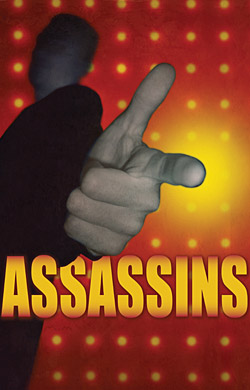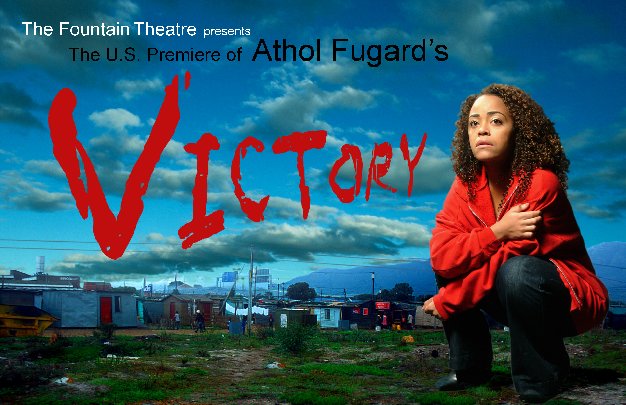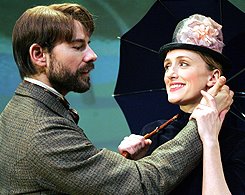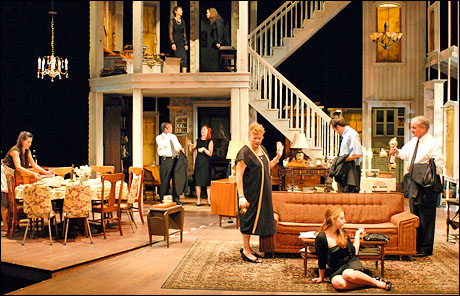“I never was an opera fan–about twenty-five musically supreme masterpieces in this curious medium apart.”
Hans Keller, Criticism
Archives for February 2008
CAAF: Morning coffee
I hab a cold so we’re favoring the light and amusing this morning.
• Daniel Kalder plumbs the Russian translation of his book, The Lost Cosmonaut. (Via.)
• All the ladies swoon for the man with the silver tongue: “… and it seems to me that this sprang like a golden sapling
out of the mad, beautiful head of Paul Thomas Anderson.” (Relatedly, I appreciated the theory advanced here for Rebecca Miller’s bordello-co-co dress.
• Maybe it’s the Alka-Seltzer Cold talking but Garfield minus Garfield is kind of great? (Via.)
TT: Almanac
The already known had once more been confirmed
By psychological experiment.
Robert Frost, “At Woodward’s Gardens”
TT: The enemy of the best
My friend Rick Brookhiser recently posed this memeworthy notion: “It would make an exercise to say what are your least favorite works by artists you mostly, or sometimes, love.” So it would, and I’ve been thinking it over ever since. Here’s my Top (or Bottom) Five:
 • Pierre-Auguste Renoir was a very great artist who painted far more than his share of very bad pictures, from the insipid young girls of his middle years to the deliquescent nudes of his old age. My first visit to the Barnes Collection, which owns more second- and third-rate Renoirs than any other museum in the world, was alarmingly instructive in this regard. To be sure, the competition is stiff, but the 1918 Bathers that I saw there in 2005 was without a doubt the worst Renoir that I’ve ever seen anywhere.
• Pierre-Auguste Renoir was a very great artist who painted far more than his share of very bad pictures, from the insipid young girls of his middle years to the deliquescent nudes of his old age. My first visit to the Barnes Collection, which owns more second- and third-rate Renoirs than any other museum in the world, was alarmingly instructive in this regard. To be sure, the competition is stiff, but the 1918 Bathers that I saw there in 2005 was without a doubt the worst Renoir that I’ve ever seen anywhere.
• Yes, Antony Tudor was a great choreographer–sometimes–but I confess without the slightest reluctance that Pillar of Fire, his heavy-breathing, deadly serious 1942 dance version of Schoenberg’s Verklärte Nacht, makes me giggle.
 • My admiration for Stephen Sondheim is no secret to regular readers of this blog, but some of his musicals are better than others, and Assassins, in which he seeks to prove the essential falsehood of the American dream by portraying a group of successful and would-be presidential assassins, seems to me to be flawed beyond repair.
• My admiration for Stephen Sondheim is no secret to regular readers of this blog, but some of his musicals are better than others, and Assassins, in which he seeks to prove the essential falsehood of the American dream by portraying a group of successful and would-be presidential assassins, seems to me to be flawed beyond repair.
I wrote a review of the 2004 Broadway revival in which I summed up my reservations: “Do the lives of these misfits have any larger meaning? Perhaps, but you can’t prove it by Assassins, which merely asserts their significance rather than demonstrating it–and that’s where the show runs off the road. To be effective, political theater must deal in fact, not fancy, and most of America’s presidential assassins were in fact driven not by ideology but madness. Assassins leaves no doubt of that, especially in ‘The Ballad of Guiteau,’ in which Charles Guiteau, who shot and killed James Garfield, displays his megalomania to spectacular effect. And what do such delusions tell us about the validity of the American dream? Nothing, which is why Assassins makes no sense.”
• Howard Hawks was one of Hollywood’s greatest directors, but when he was bad, he was perfectly awful, and I’d be hard pressed to think of a lamer Hawks comedy than Man’s Favorite Sport? It’s not the worst movie he ever made–that would be Red Line 7000–but it’s bad enough to briefly make you wonder what you ever saw in him.
• “There are some sacrifices which should not be demanded twice of any man,” George Bernard Shaw wrote, “and one of them is listening to Brahms’ Requiem.” I’m with him, and then some. It’s been a quarter-century or so since I last sat through a complete performance of A German Requiem, and I hope and expect to go to my grave without voluntarily hearing that ponderous piece of musical mortuary science again.
Over to you, OGIC and CAAF.
TT: Almanac
“A real failure does not need an excuse. It is an end in itself.”
Gertrude Stein, Four in America
TT: The politics of love and hate
In today’s Wall Street Journal drama column I report on two more of the shows I saw during my recent trip to California, Victory in Hollywood and Blood Knot in San Francisco, plus the Broadway revival of Sunday in the Park with George. Here’s a sample.
* * *
 Athol Fugard wondered for a time whether the ending of apartheid in South Africa might also put an end to his playwriting career. Most of his best-known works, starting with “Blood Knot,” the 1961 two-man play that brought him worldwide acclaim, had been set against the brutal backdrop of the racial segregation that the white minority of his native land imposed on its black majority in 1948. Would Mr. Fugard have anything of equal interest to say about the new South Africa brought into being by the demise of apartheid–and would that long-awaited deliverance from evil turn his older plays into stale period pieces? The answers can be found in two productions now playing on the West Coast, the American Conservatory Theater’s San Francisco revival of “Blood Knot” and the American premiere of “Victory,” Fugard’s latest play, which is being presented not on Broadway but in a tiny theater located in–of all places–Hollywood.
Athol Fugard wondered for a time whether the ending of apartheid in South Africa might also put an end to his playwriting career. Most of his best-known works, starting with “Blood Knot,” the 1961 two-man play that brought him worldwide acclaim, had been set against the brutal backdrop of the racial segregation that the white minority of his native land imposed on its black majority in 1948. Would Mr. Fugard have anything of equal interest to say about the new South Africa brought into being by the demise of apartheid–and would that long-awaited deliverance from evil turn his older plays into stale period pieces? The answers can be found in two productions now playing on the West Coast, the American Conservatory Theater’s San Francisco revival of “Blood Knot” and the American premiere of “Victory,” Fugard’s latest play, which is being presented not on Broadway but in a tiny theater located in–of all places–Hollywood.
The Fountain Theatre, one of California’s best drama companies, performs in a 78-seat house whose front row of seats is three feet from the trapezoidal stage. You can’t get much closer than that, and “Victory,” an hour-long play about two angry young blacks (Lovensky Jean-Baptiste and Tinashe Kajese) who break into the home of an aging, demoralized white liberal (Morland Higgins) in the middle of the night, is well served by the miniature scale and fierce concentration of this production, which is supremely well acted by the three-person cast (Ms. Kajese in particular) and staged with relentless intensity by Stephen Sachs, the company’s co-artistic director…
The natural intimacy of a house like the Fountain must necessarily be simulated on the American Conservatory Theater’s large proscenium stage, and one of the things I liked best about that company’s revival of “Blood Knot” was the precision with which Alexander V. Nichols, who designed the set, directs your eye to the pitiful one-room shack at center stage in which the action unfolds. The play itself is a rich character study in which Mr. Fugard passes the adamantine reality of apartheid through the refracting prism of Sartre and Camus to show us two black half-brothers cleaving uncomfortably together in the midst of a hostile world. The setting of “Blood Knot” is by definition political, but what takes place there is intensely, passionately personal, for what interests Mr. Fugard most is not politics but love. “You see, we’re tied together,” the light-skinned Morris (Jack Willis) tells the dark-skinned Zach (Steven Anthony Jones) at play’s end. “It’s what they call the blood knot…the bond between brothers.” A metaphor, yes, but is it essentially public or private? Part of the beauty of “Blood Knot” is that Mr. Fugard doesn’t make you choose.
I found A.C.T.’s 2007 production of “Hedda Gabler” to be competent but ordinary, but there is nothing at all commonplace about “Blood Knot.” Mr. Jones and Mr. Willis dig deeply into their long, difficult roles…
 The original Broadway production of “Sunday in the Park with George” ran for 604 performances and won 10 Tonys and a Pulitzer Prize, but the show itself remains one of Stephen Sondheim’s problem children. The first act, a fictionalized re-creation of the making of “A Sunday Afternoon on the Island of La Grande Jatte,” Georges Seurat’s 1886 pointillist masterpiece, is itself a masterpiece of musical theater, a light-textured yet profound parable of the mystery of creation and the self-imposed, single-minded isolation of the creative artist. Not so the second act, in which Mr. Sondheim and James Lapine tell a parallel tale of the modern-day art world that lapses into the same cloying sententiousness that mars the second act of “Into the Woods,” their 1987 fairy-tale musical: Anything you do,/Let it come from you./Then it will be new.
The original Broadway production of “Sunday in the Park with George” ran for 604 performances and won 10 Tonys and a Pulitzer Prize, but the show itself remains one of Stephen Sondheim’s problem children. The first act, a fictionalized re-creation of the making of “A Sunday Afternoon on the Island of La Grande Jatte,” Georges Seurat’s 1886 pointillist masterpiece, is itself a masterpiece of musical theater, a light-textured yet profound parable of the mystery of creation and the self-imposed, single-minded isolation of the creative artist. Not so the second act, in which Mr. Sondheim and James Lapine tell a parallel tale of the modern-day art world that lapses into the same cloying sententiousness that mars the second act of “Into the Woods,” their 1987 fairy-tale musical: Anything you do,/Let it come from you./Then it will be new.
In Sam Buntrock’s London production, which the Roundabout Theatre Company has imported to Broadway for a three-month run, design is the key. David Farley’s bare-walled set serves as the screen for a complex series of digitally animated projections executed by Timothy Bird that seek to simulate the lengthy process by which Seurat’s great painting (which is now one of the glories of the Art Institute of Chicago) came into being. The results, which are spectacular enough to make a Manhattan crowd gasp, add up to the most aesthetically persuasive use of video technology ever to be seen on a Broadway stage. I have no doubt that they will soon be imitated the world over.
On occasion, though, Mr. Bird’s bedazzling visual trickery gets between the actors and the audience, and sometimes I wondered whether so excellent a cast might not have been better served by a less elaborate production. Certainly Daniel Evans, who played George in London and is now repeating the role on Broadway, needs no electronic assistance to animate his part….
* * *
Read the whole thing here.
TT: Almanac
And when the woman that you wanted goes,
You can say to yourself, “Well, I give what I give.”
But the woman who won’t wait for you knows
That, however you live,
There’s a part of you always standing by,
Mapping out the sky,
Finishing a hat…
Starting on a hat…
Finishing a hat…
Look, I made a hat…
Where there never was a hat.
Stephen Sondheim, “Finishing the Hat” (from Sunday in the Park with George)
TT: So you want to see a show?
Here’s my list of recommended Broadway and off-Broadway shows, updated weekly. In all cases, I gave these shows favorable reviews in The Wall Street Journal when they opened. For more information, click on the title.
Warning: Broadway shows marked with an asterisk were sold out, or nearly so, last week.
BROADWAY:
• Alfred Hitchcock’s The 39 Steps * (comedy, G, suitable for bright children, closes Mar. 23, reviewed here)
 • August: Osage County (drama, R, adult subject matter, closes Apr. 20 and reopens Apr. 29 at the Music Box Theatre for an open-ended run, reviewed here)
• August: Osage County (drama, R, adult subject matter, closes Apr. 20 and reopens Apr. 29 at the Music Box Theatre for an open-ended run, reviewed here)
• Avenue Q * (musical, R, adult subject matter and one show-stopping scene of puppet-on-puppet sex, reviewed here)
• A Chorus Line (musical, PG-13/R, adult subject matter, reviewed here)
• Grease * (musical, PG-13, some sexual content, reviewed here)
• The Homecoming (drama, R, adult subject matter, closes Apr. 13, reviewed here)
• Is He Dead? (farce, G, reasonably family-friendly, reviewed here)
• The Little Mermaid * (musical, G, entirely suitable for children, reviewed here)
• November (comedy, PG-13, profusely spattered with obscene language, here)
• The Seafarer (drama, PG-13, adult subject matter, closes Mar. 30, reviewed here)
ON TOUR:
• Moby-Dick–Rehearsed (drama, G, not suitable for children, touring the U.S. through May 17, reviewed here)
CLOSING SOON:
• Come Back, Little Sheba (drama, PG-13, adult subject matter, closes Mar. 16, reviewed here)
• Rock ‘n’ Roll (drama, PG-13, way too complicated for kids, closes Mar. 9, reviewed here)
CLOSING NEXT WEEK:
• The Farnsworth Invention (drama, PG-13, closing Mar. 2, reviewed here)
• Hunting and Gathering (comedy, PG-13, adult subject matter, closes Mar. 1, reviewed here)
CLOSING SUNDAY:
• The Fantasticks (musical, G, suitable for children old enough to enjoy a love story, closes Feb. 24, reviewed here)
